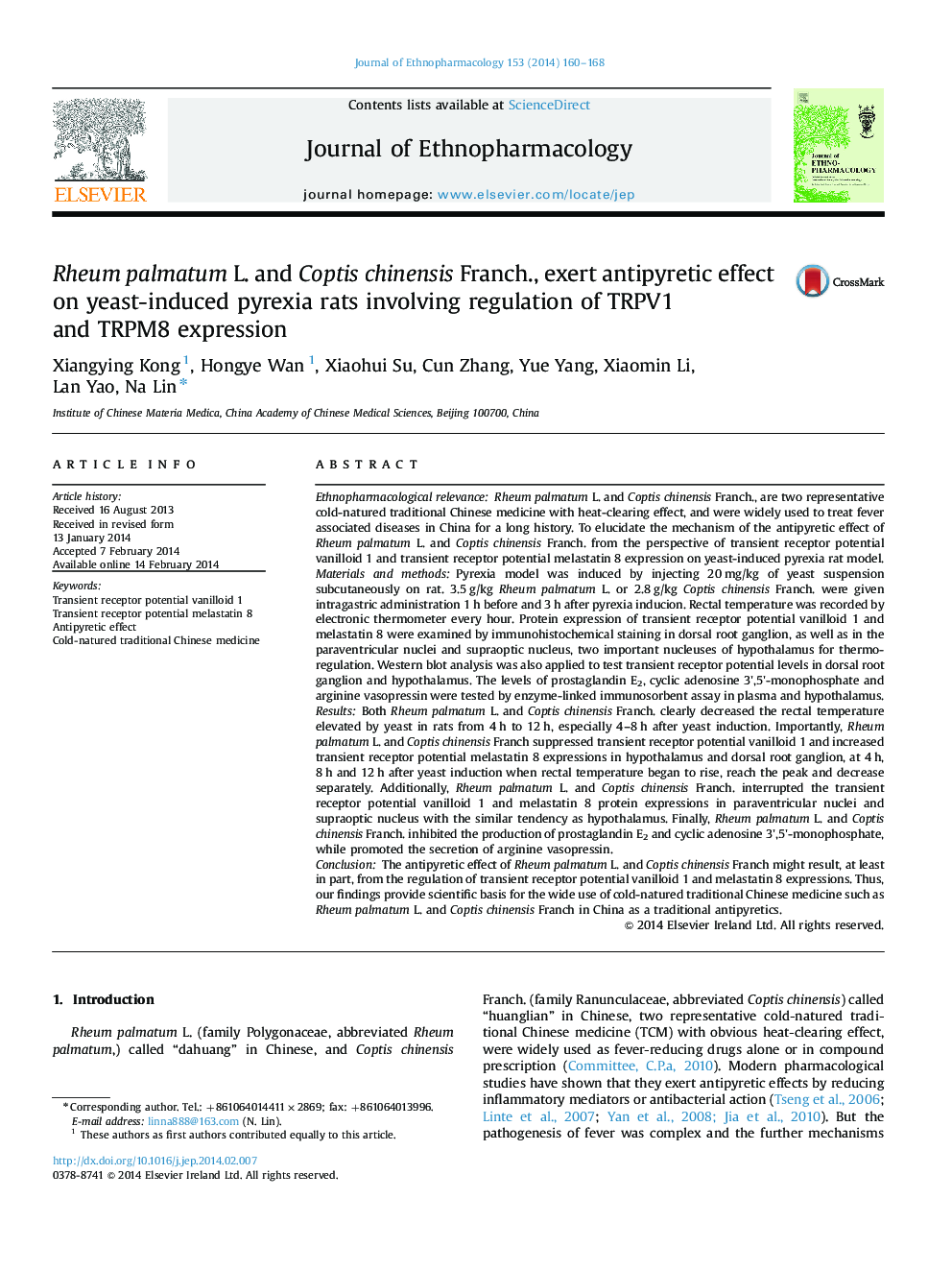| کد مقاله | کد نشریه | سال انتشار | مقاله انگلیسی | نسخه تمام متن |
|---|---|---|---|---|
| 2545379 | 1123952 | 2014 | 9 صفحه PDF | دانلود رایگان |

Ethnopharmacological relevanceRheum palmatum L. and Coptis chinensis Franch., are two representative cold-natured traditional Chinese medicine with heat-clearing effect, and were widely used to treat fever associated diseases in China for a long history. To elucidate the mechanism of the antipyretic effect of Rheum palmatum L. and Coptis chinensis Franch. from the perspective of transient receptor potential vanilloid 1 and transient receptor potential melastatin 8 expression on yeast-induced pyrexia rat model.Materials and methodsPyrexia model was induced by injecting 20 mg/kg of yeast suspension subcutaneously on rat. 3.5 g/kg Rheum palmatum L. or 2.8 g/kg Coptis chinensis Franch. were given intragastric administration 1 h before and 3 h after pyrexia inducion. Rectal temperature was recorded by electronic thermometer every hour. Protein expression of transient receptor potential vanilloid 1 and melastatin 8 were examined by immunohistochemical staining in dorsal root ganglion, as well as in the paraventricular nuclei and supraoptic nucleus, two important nucleuses of hypothalamus for thermoregulation. Western blot analysis was also applied to test transient receptor potential levels in dorsal root ganglion and hypothalamus. The levels of prostaglandin E2, cyclic adenosine 3׳,5׳-monophosphate and arginine vasopressin were tested by enzyme-linked immunosorbent assay in plasma and hypothalamus.ResultsBoth Rheum palmatum L. and Coptis chinensis Franch. clearly decreased the rectal temperature elevated by yeast in rats from 4 h to 12 h, especially 4–8 h after yeast induction. Importantly, Rheum palmatum L. and Coptis chinensis Franch suppressed transient receptor potential vanilloid 1 and increased transient receptor potential melastatin 8 expressions in hypothalamus and dorsal root ganglion, at 4 h, 8 h and 12 h after yeast induction when rectal temperature began to rise, reach the peak and decrease separately. Additionally, Rheum palmatum L. and Coptis chinensis Franch. interrupted the transient receptor potential vanilloid 1 and melastatin 8 protein expressions in paraventricular nuclei and supraoptic nucleus with the similar tendency as hypothalamus. Finally, Rheum palmatum L. and Coptis chinensis Franch. inhibited the production of prostaglandin E2 and cyclic adenosine 3׳,5׳-monophosphate, while promoted the secretion of arginine vasopressin.ConclusionThe antipyretic effect of Rheum palmatum L. and Coptis chinensis Franch might result, at least in part, from the regulation of transient receptor potential vanilloid 1 and melastatin 8 expressions. Thus, our findings provide scientific basis for the wide use of cold-natured traditional Chinese medicine such as Rheum palmatum L. and Coptis chinensis Franch in China as a traditional antipyretics.
Figure optionsDownload high-quality image (247 K)Download as PowerPoint slide
Journal: Journal of Ethnopharmacology - Volume 153, Issue 1, 11 April 2014, Pages 160–168